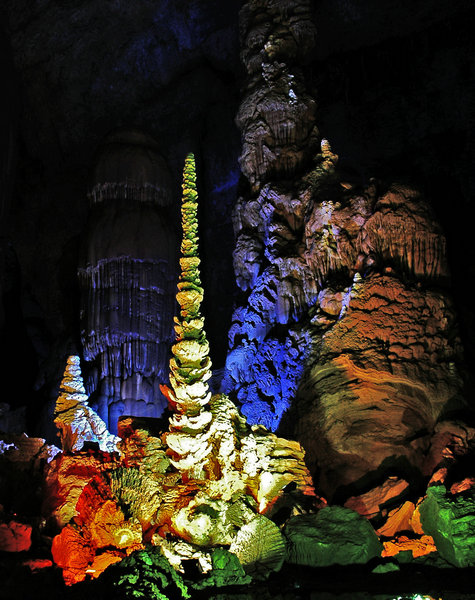Exploring a portal to the underworld
 |
|
The Zhijin Cave in Guizhou hosts an amazing underworld with over 40 types of karst formations.[Photo by Chen Debin/ China Daily] |
The "holy holes" vomited vapor.
That's all the villagers knew. Or wanted to know.
Nobody dared go too close to the gaping mouths that exhaled twists of mist from the mountainsides in rural Guizhou province.
Indeed, residents of Minzhai village believed these openings were perhaps portals to the dwelling of a mountain god.
That is, until a tourism resource prospecting team arrived in 1980.
They discovered the cavities leading to one of the world's largest karst caves.
Zhijin Cave's 5.5 million-cubic-meter chamber is 6.6 kilometers long. Its ceiling soars 150 meters at the highest places, and its floor spreads up to 175 meters, wall-to-wall.
Indeed, it's big enough to make you feels mall.
Rather than serve as the abode of a deity, the cavern carved into the earth half a million years ago is the habitat of serpents, bats and boars.
The subterranean netherworld hosts over 40 types of karst formations, including stalagmites and stalactites that jut over 100 meters.
Some form mirror images of each other. It's said water dropping from the ceiling adds a fifth of a millimeter to the stalagmites' tips a year. The sands of time have fused some into hourglass-shaped pillars.
Their surfaces undulate with the accumulations of sedimentary minerals collected over hundreds of millennia.
The watercourse of Zhijin's long evaporated underground river remains.
There are only two young bright white stalagmites, 3-4 meters high, still growing inside the cave. (Changes in water and minerals have colored the other white formations brown over the millennia.)
UNESCO named the cave a World Heritage Site and World Geology Park in September.
Visitors can hike the entire length of the cave along stone steps. (It's sort of like mountain climbing-in reverse.)
Sound-controlled lights illuminate 47 chambers along the way, with colored bulbs in turn shining on the formations within.
Many formations have been assigned anthropomorphic appellations related to Buddhism or folklore. Stones take the shape of flowers, drums, shields and bells that take on a netherworld feel when viewed through the thin haze that hangs in the clammy air.
Some spelunkers say Zhijin contains nearly everything a karst cave can produce and call it "a museum of Chinese caves".
It burrows into the mountain in the 170-square-kilometer scenic area that also houses the Wujiang River's origin and a deep valley.
The area is home to such ethnic groups as the Miao, Bouyei and Yi, who live undisturbed by local tourism development. They've sustained traditional lifestyles as farmers, herbalists, hunters and weavers.
Their presence adds anthropology to geology, meaning greater allure for Zhijin county's visitors-one that spans from above to below the earth.
If you go
Zhijin is about two hours by bus from the provincial capital, Guiyang. It takes two hours and lots of stamina to complete the two-hour trek through the cave. Visitors are advised to wear warm clothes that breathe well.
















